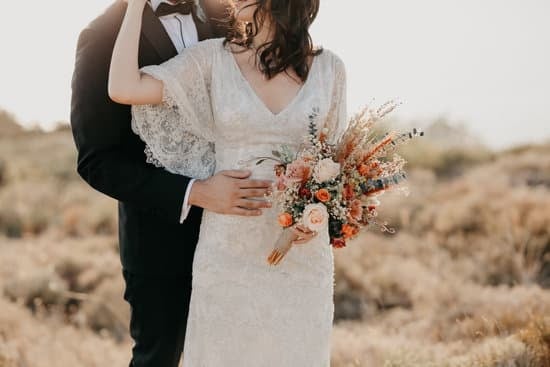When it comes to the placement of a wedding band, tradition and symbolism play a significant role. The question of whether the wedding band should go on the inside or outside carries with it various cultural perspectives and debates. Understanding the history and significance behind wearing a wedding band can provide insight into this age-old tradition.
The placement of the wedding band has deep roots in history, dating back to ancient civilizations and cultural traditions. These origins serve as the foundation for the symbolic meaning behind wearing a ring as a representation of love, commitment, and partnership. As such, different cultures have developed their own customs and interpretations regarding where the wedding band should be placed.
In this article, we will delve into the rich history of wedding bands and explore the various cultural perspectives that shape the debate over its placement. We will also discuss factors to consider when deciding where to place the wedding band and provide guidance on how to determine the correct placement based on personal preference and tradition.
By examining these aspects, we aim to shed light on the importance of understanding the symbolism and tradition behind the placement of the wedding band.
The History of Wedding Bands
The tradition of exchanging wedding bands dates back to ancient Egypt, where reeds and hemp were used to create rings symbolizing eternal love. These early bands were placed on the left-hand ring finger, as it was believed that a vein ran directly from this finger to the heart. This belief in the “vena amoris” has carried through the centuries and become a widespread practice in many cultures.
In ancient Rome, wedding bands were often made of iron and symbolized strength and permanence. The circular shape of the band was also significant, representing eternity and infinity. As Christianity spread throughout Europe, the exchange of wedding bands became incorporated into religious ceremonies, further solidifying the tradition.
Throughout history, there have been variations in how wedding bands are worn. In some cultures, such as in parts of Europe and India, the wedding band is traditionally worn on the right hand. However, in many Western cultures, including the United States and most of Europe, it’s common to wear the wedding band on the left hand.
- In ancient Egypt, reeds and hemp were used to create rings
- The tradition of wearing rings on left-hand ring finger due to vena amoris
- Wedding bands in ancient Rome made of iron symbolizing strength and permanence
Understanding these historical origins can provide valuable insight into the significance of wearing a wedding band and help individuals make an informed decision about where to place their own ring.
The Significance of Wearing the Wedding Band
Wearing a wedding band is a time-honored tradition that symbolizes the eternal bond between partners. The circular shape of the band represents infinity and the unending love and commitment between two individuals. From ancient times, rings have been associated with symbolizing eternity and unity, making them an essential part of wedding ceremonies across various cultures.
The act of exchanging wedding bands dates back to ancient Egypt, where rings were believed to be symbolic of eternity, with no beginning or end. The custom eventually spread to other civilizations, including the Romans, who also embraced the tradition of wearing wedding bands as a symbol of commitment and fidelity.
In many cultures, the act of wearing a wedding band is also seen as a public declaration of one’s marital status. It serves as a visible symbol to others that an individual is committed to their partner.
This symbolic gesture not only signifies the union between two people but also acknowledges the couple’s commitment to each other in the presence of their family, friends, and society at large. Additionally, it can also serve as a reminder to the wearers themselves of their promise and devotion to each other.
- Wedding bands have historical significance dating back to ancient civilizations
- Rings are symbols of eternity and unending love
- Wearing a wedding band serves as a public declaration of marital status
Does the Wedding Band Go on the Inside or Outside? The Debate and Various Cultural Perspectives
The debate over whether the wedding band should go on the inside or outside has been a topic of discussion for many couples and cultures around the world. While there is no definitive answer, as it largely depends on personal preference and cultural traditions, understanding the various perspectives can help individuals make an informed decision.
Western Tradition
In Western cultures, the traditional placement for the wedding band is on the inside, closest to the heart. This practice symbolizes the intimate connection between spouses and represents their commitment and love for each other. It is believed that wearing the wedding band on the inside finger also provides protection for the precious metal.
Eastern Tradition
In contrast, some Eastern cultures have a different perspective on where to place the wedding band. For example, in certain Eastern European countries, it is customary to wear the wedding band on the outside of the engagement ring. This tradition signifies that marriage is a public declaration of commitment and love, and that couples are proud to display their bond to others.
Modern Perspectives
With changing times and cultural influences, modern couples are increasingly opting for personalized approaches when it comes to placing their wedding bands. Some may choose to stack both rings on one finger, while others may prefer wearing them on separate fingers. Ultimately, what matters most is that the placement of the wedding band holds meaning and significance for the couple.
Understanding these various cultural perspectives can help individuals navigate this decision with thoughtfulness and intentionality. Whether following traditional customs or forging new ones, what does matter is that wearing a wedding band symbolizes love, commitment, and partnership – regardless of where it is placed on the finger.
Factors to Consider When Deciding Where to Place the Wedding Band
When it comes to deciding where to place the wedding band, there are several factors that couples should consider. The placement of the wedding band can hold different symbolic meanings and cultural significance, so it’s important to take these factors into account when making this decision.
Cultural Traditions and Beliefs
Different cultures have their own traditions and beliefs when it comes to wearing wedding bands. In some cultures, the wedding band is traditionally worn on the inside, closest to the heart, as a symbol of the couple’s eternal love and commitment.
On the other hand, in some cultures, wearing the wedding band on the outside signifies that the couple is open about their relationship status. Considering your cultural background and beliefs can help you determine where you want to place your wedding band.
Practicality and Comfort
Another factor to consider is practicality and comfort. Some individuals may find it more comfortable to wear their wedding band on the inside, as it may be less likely to snag on clothing or other objects. Others may prefer wearing it on the outside for ease of removal or simply because they find it more comfortable in that position. It’s important for couples to discuss their preferences and take into consideration what feels most comfortable for them.
Matching With Engagement Ring
For many individuals, considering how the wedding band will look alongside their engagement ring is crucial. Some engagement ring designs may influence where the wedding band is worn for aesthetic reasons or practical considerations. Couples should take into account how the two rings will fit together on their finger when making this decision.
Understanding these various factors can help couples make an informed decision about where they want to place their wedding bands, taking into account both symbolic meanings and practical considerations. Ultimately, each couple should choose what feels right for them based on their beliefs, comfort, and personal preferences.
How to Determine the Correct Placement for Your Wedding Band
The placement of the wedding band is a decision that holds significant meaning for many couples. While there are traditional customs and cultural perspectives surrounding this debate, ultimately the decision comes down to personal preference. However, for those who are unsure about where to place their wedding band, there are factors to consider and methods for determining the correct placement.
One important factor to consider when deciding where to place your wedding band is the style of your engagement ring, if you have one. Some engagement rings are designed to be worn with the wedding band stacked underneath, while others may be meant to be worn on top. It’s essential to take into account how the rings fit together and complement each other when making your decision.
In addition to considering the style of your rings, it can also be helpful to think about practicality. For individuals who lead active lifestyles or work with their hands, wearing the wedding band on the inside may offer more protection and prevent damage to the ring. On the other hand, some may prefer wearing their wedding band on the outside as a statement piece or way of prominently displaying their commitment.
Finally, if you are still unsure about where to place your wedding band, a helpful method for determining the correct placement is simply trying out different options and seeing what feels most comfortable and meaningful for you. You can test out wearing your wedding band on both the inside and outside for a period of time and see which placement resonates with you the most.
Ultimately, the decision should be based on what feels right for you as an individual and as a couple.
| Factors Considered | Consideration |
|---|---|
| Style of Engagement Ring | Complementing rings |
| Practicality | Protection and lifestyle |
| Personal Preference | Comfort and meaning |
The Role of Personal Preference in the Placement of the Wedding Band
The placement of the wedding band is a highly personal decision that varies from person to person. While there are traditional guidelines for where the ring should be worn, ultimately, it comes down to personal preference. Some individuals prefer to wear their wedding band on the inside, closest to their heart as a symbolic gesture. Others choose to wear it on the outside, as a way to showcase their commitment to the world.
For many people, the decision of whether to wear the wedding band on the inside or outside is influenced by cultural and familial traditions. In some cultures, there are specific customs regarding the placement of the wedding band, and individuals may choose to honor these customs in their own marriages. For example, in some Eastern European countries such as Russia and Poland, it is common for couples to wear their wedding bands on the right hand.
Personal comfort also plays a significant role in determining where one chooses to wear their wedding band. Some individuals find that wearing a ring on the inside of their finger feels more comfortable and secure, while others may prefer the feeling of having it on the outside. Additionally, factors such as hand dominance and daily activities can influence which placement feels most natural for each individual.
It’s important for couples to have an open and honest conversation about their preferences when it comes to wearing their wedding bands. Finding a solution that feels meaningful and comfortable for both partners will ensure that each person can proudly display this symbol of love and commitment in a way that holds personal significance.
| Aspect | Consideration |
|---|---|
| Cultural Traditions | Influence personal preference |
| Comfort | Affects how one wears their ring |
| Open Communication | Important for finding a mutually meaningful solution |
Conclusion
In conclusion, the placement of the wedding band is a deeply symbolic and traditional aspect of marriage that carries significant meaning across different cultures. Whether it goes on the inside or outside ultimately depends on personal preference and cultural practices. Understanding the history and significance behind wearing the wedding band can help individuals make an informed decision about where to place their ring.
The debate over whether the wedding band should go on the inside or outside revolves around various cultural perspectives, with some traditions emphasizing keeping the ring close to the heart by placing it on the inside, while others prioritize showcasing the ring by wearing it on the outside. Ultimately, what matters most is understanding the symbolism and tradition behind this meaningful gesture.
When deciding where to place your wedding band, it’s important to consider your own beliefs, values, and personal preferences. Additionally, couples may choose to honor each other’s cultural backgrounds when making this decision, further highlighting the significance of understanding the symbolism and tradition behind the placement of the wedding band. Regardless of individual choices, what remains paramount is recognizing and respecting the deep-rooted symbolism and tradition associated with wearing a wedding band.
Frequently Asked Questions
Which Goes First Engagement and Wedding Ring?
Traditionally, the engagement ring is worn first, closest to the heart, followed by the wedding ring. This symbolizes the progression from engagement to marriage and is a common practice in many cultures.
What Is the Correct Way to Wear Your Wedding Ring?
The correct way to wear your wedding ring is on the ring finger of your left hand, following the placement of the engagement ring. Some cultural or religious traditions may dictate wearing it on the right hand, but this varies widely.
Why Do You Wear Your Wedding Ring on the Inside?
Wearing the wedding ring on the inside, closer to your palm, is believed to have originated from ancient Egyptian beliefs that this finger contains a vein that leads directly to the heart. It symbolizes love and commitment flowing directly from the heart through this vein.

I have been involved in marriages for over 20 years helping couples and singles understand more about them.





